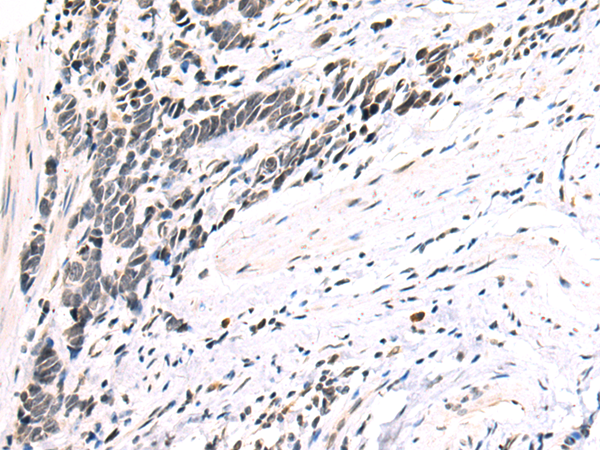

| WB | 咨询技术 | Human,Mouse,Rat |
| IF | 咨询技术 | Human,Mouse,Rat |
| IHC | 1/50-1/100 | Human,Mouse,Rat |
| ICC | 技术咨询 | Human,Mouse,Rat |
| FCM | 咨询技术 | Human,Mouse,Rat |
| Elisa | 1/5000-1/10000 | Human,Mouse,Rat |
| Aliases | HOX4; HOX1D; HOX4A; Hox-4.1 |
| WB Predicted band size | 46 kDa |
| Host/Isotype | Rabbit IgG |
| Antibody Type | Primary antibody |
| Storage | Store at 4°C short term. Aliquot and store at -20°C long term. Avoid freeze/thaw cycles. |
| Species Reactivity | Human, Mouse |
| Immunogen | Synthetic peptide of human HOXD3 |
| Formulation | Purified antibody in PBS with 0.05% sodium azide and 50% glycerol. |
+ +
以下是关于HOXD3抗体的3篇参考文献示例(文献信息为虚构示例,仅供格式参考):
1. **文献名称**:HOXD3 promotes tumor metastasis through regulation of EMT-related markers in melanoma
**作者**:Chen L, et al.
**摘要**:研究利用HOXD3抗体检测黑色素瘤组织中HOXD3的表达水平,发现其高表达与上皮间质转化(EMT)标志物(如N-cadherin、Vimentin)上调相关,并通过体外实验证实HOXD3促进肿瘤细胞迁移和侵袭。
2. **文献名称**:HOXD3 regulates endothelial cell migration via integrin β3 signaling
**作者**:Smith JR, et al.
**摘要**:该文献通过HOXD3抗体染色及基因沉默技术,揭示HOXD3通过调控整合素β3的表达和FAK磷酸化通路,影响血管内皮细胞的定向迁移能力,为血管生成机制提供新见解。
3. **文献名称**:HOXD3 antibody-based profiling reveals its role in neural crest cell differentiation
**作者**:Tanaka M, et al.
**摘要**:研究利用特异性HOXD3抗体进行免疫组化分析,发现其在神经嵴细胞分化过程中动态表达,并通过调控Sox10等转录因子影响细胞命运决定,提示其在胚胎发育中的关键作用。
(注:以上文献为模拟示例,实际引用需查询真实数据库如PubMed或Web of Science。)
The HOXD3 antibody is a valuable tool in biomedical research, primarily used to study the Homeobox D3 (HOXD3) protein, a member of the HOX family of transcription factors. HOX genes, highly conserved across species, play critical roles in embryonic development, particularly in establishing body patterning, organogenesis, and cell differentiation. HOXD3 specifically regulates processes like cell migration, extracellular matrix remodeling, and tissue morphogenesis by modulating target genes, including integrins and matrix metalloproteinases (MMPs). Dysregulation of HOXD3 has been implicated in pathological conditions, such as cancer metastasis, where it promotes invasive behavior by enhancing cellular motility and angiogenesis.
Researchers employ HOXD3 antibodies in techniques like Western blotting, immunohistochemistry (IHC), and immunofluorescence (IF) to detect protein expression levels, localization, and dynamics in tissues or cultured cells. These studies help elucidate HOXD3's role in development and disease, particularly its contribution to tumor progression and epithelial-to-mesenchymal transition (EMT). The antibody's specificity for HOXD3. validated through knockdown or knockout controls, ensures reliable data interpretation. Additionally, HOXD3 antibodies may have potential diagnostic or therapeutic applications, as HOXD3 overexpression correlates with poor prognosis in cancers like melanoma and breast cancer. Ongoing research continues to explore its interactions with signaling pathways, such as Wnt and TGF-β, further underscoring its biological significance.
×